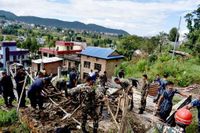In the picturesque hills of Darjeeling and across the border in Nepal, relentless monsoon rains have unleashed a wave of devastation, leaving dozens dead, many missing, and entire communities struggling to recover. Over the span of just three days, from October 4 to October 6, 2025, both regions have been battered by floods and landslides, uprooting lives and infrastructure in their wake.
According to Reuters, the Indian hill region of Darjeeling in West Bengal was hit particularly hard. At least 18 people have been confirmed dead after torrents of rain washed away homes, roads, and bridges. The situation remains grim, with several people still missing as of October 6, and officials warning that the death toll could rise as more information comes in from remote, inaccessible areas.
"Two iron bridges have collapsed, several roads have been damaged and flooded, huge tracts of land ... have been inundated," Mamata Banerjee, the chief minister of West Bengal, posted on X (formerly Twitter). She added that the affected districts include Darjeeling, Kalimpong, Jalpaiguri, and Alipurduar—regions renowned for their lush tea plantations and breathtaking mountain vistas.
But the havoc didn’t stop at the Indian border. In neighboring Nepal, the catastrophe deepened. The death toll there reached a staggering 60, including 15 children, according to sources from Nepal’s Home Ministry cited by The Hindu. The brunt of the disaster was felt in Ilam district in Koshi province, where 37 people lost their lives to a combination of floods, landslides, lightning, and road accidents. Other districts, including Panchathar, Udayapur, Rautahat, Kavre, Khotang, Sunsari, Morang, Mohattari, Sindhuli, and Sindhupalchowk, also reported fatalities.
The monsoon’s reach was broad and unyielding. Five of Nepal’s seven provinces—Koshi, Madhes, Bagmati, Gandaki, and Lumbini—were all under the grip of heavy rainfall, as reported by the National Disaster and Risk Reduction Management Authority (NDRRMA). The Nepal Army, Nepal Police, and Armed Police Force (APF) scrambled to conduct rescue operations in the affected areas, digging through mud and debris in a race against time to find survivors and clear blocked roads.
Back in Darjeeling, the aftermath of the disaster was immediately visible. Highway traffic ground to a halt after an iron bridge spanning the Balason River—an important link between the city of Siliguri in the plains and the hill town of Mirik—collapsed under the force of the rain-swollen waters. Other roads caved in, and large amounts of debris left many areas virtually unreachable. Local disaster management officials described the scene as chaotic, noting that the sheer volume of debris made it nearly impossible for rescuers to reach some of the most isolated villages.
Relief and restoration efforts began in earnest on October 6, but the work ahead is daunting. The region’s topography—steep slopes, winding roads, and scattered settlements—complicates rescue operations. The famous Himalayan hill resort of Darjeeling, a magnet for tourists thanks to its panoramic views of Mount Kanchenjunga (the world’s third-highest peak), suddenly found itself cut off and vulnerable. Mamata Banerjee issued a direct appeal to tourists: "Please stay put until you are safely evacuated." For many, the dream vacation had turned into a nightmare, with safety now the only priority.
Across the border, Nepal’s government responded quickly to the mounting tragedy. On October 5, authorities announced an immediate compensation of 200,000 Nepali rupees for the families of those killed in rain-related disasters. In addition, the NDRRMA stated that injured survivors would receive free treatment at government hospitals. This swift action aimed to provide at least some measure of relief to those grappling with the loss of loved ones and the destruction of their homes.
"The government will provide immediate relief to the next of kin of those who lost their lives," a statement from the NDRRMA read, underscoring the urgency of the situation. Meanwhile, rescue teams, including the Nepal Army and police forces, pressed on with their search for survivors, often working in treacherous conditions as more rain was forecast for the coming days.
The scale of the disaster has brought into sharp focus the region’s vulnerability to extreme weather. The monsoon season, which typically brings much-needed rain to South Asia, has in recent years become increasingly unpredictable and destructive. Experts point to a combination of factors: deforestation, unplanned urban expansion, and the effects of climate change, all of which can exacerbate the risk of floods and landslides in these mountainous areas.
For the people of Darjeeling and Nepal, recovery will be a long and arduous journey. Homes have been swept away, roads and bridges lie in ruins, and the economic impact—particularly in tea-growing districts and tourism hotspots—will be felt for months, if not years. The immediate priority remains the search for the missing and the provision of food, shelter, and medical care to the displaced.
Yet, even amid the devastation, stories of resilience and solidarity have begun to emerge. Local volunteers have joined hands with official rescue teams, braving hazardous conditions to deliver supplies and comfort to those stranded by the floods. In some villages, neighbors have opened their homes to families who lost everything, offering a reminder of the enduring human spirit in the face of disaster.
As the rains show little sign of letting up, authorities in both India and Nepal are urging caution. Weather officials in Kolkata, the capital of West Bengal, have warned that more showers are expected in the days ahead, raising the specter of further landslides and flooding. The region’s residents, already battered and weary, are bracing for what may come next, even as they begin the slow process of rebuilding their lives.
The events of early October 2025 have left an indelible mark on the hills of Darjeeling and the valleys of Nepal. The loss is profound, but the response—marked by swift government action, community solidarity, and the tireless efforts of rescue workers—offers a glimmer of hope amid the gloom. For now, the focus remains on saving lives and restoring some semblance of normalcy, even as the monsoon’s shadow lingers over this fragile, beautiful region.
